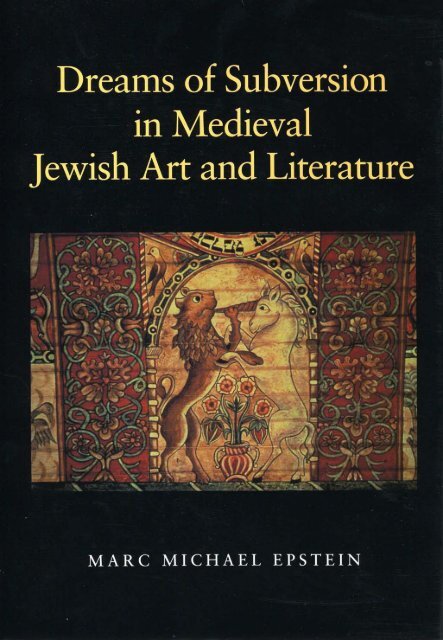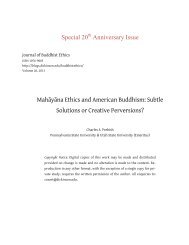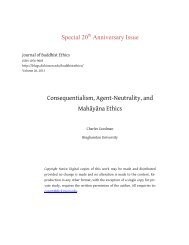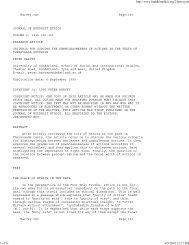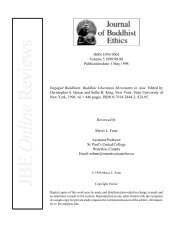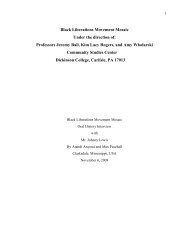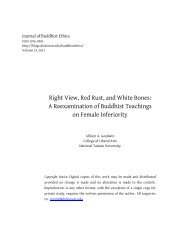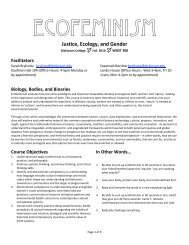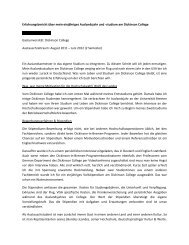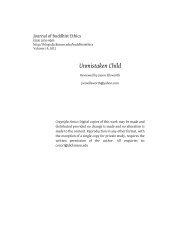Epstein, Dreams of Subversion INTRO ... - Dickinson Blogs
Epstein, Dreams of Subversion INTRO ... - Dickinson Blogs
Epstein, Dreams of Subversion INTRO ... - Dickinson Blogs
You also want an ePaper? Increase the reach of your titles
YUMPU automatically turns print PDFs into web optimized ePapers that Google loves.
<strong>Dreams</strong> <strong>of</strong> <strong>Subversion</strong> in<br />
Medieval Jewish Art & Literature
Library <strong>of</strong> Congress Cataloging-in-Publication Data<br />
<strong>Epstein</strong>, Marc Michael, 1964-<br />
<strong>Dreams</strong> <strong>of</strong> subversion in medieval Jewish art & literature I<br />
Marc Michael <strong>Epstein</strong>.<br />
p. cm.<br />
Includes bibliographical references and index.<br />
ISBN 0-271-01605-1 (alk. paper)<br />
1. Illumination <strong>of</strong> books and manuscripts, Jewish. 2. Illumination<br />
<strong>of</strong> books and manuscripts, Medieval. 3. Jewish art and symbolism .<br />
4. Jud aism- History-Medieval and early modern period, 425 - 1789.<br />
5. Animals, Mythical, in art . 1. Title.<br />
ND2935.E67 1997<br />
745.6'7'089924-dc20 96-12142<br />
CIP<br />
Copyright © 199 7 The Pennsylvania State University<br />
All rights reserved<br />
Printed in the United States <strong>of</strong> America<br />
Published by The Pennsylvania State University Press,<br />
University Park, PA 16802-1003<br />
It is the policy <strong>of</strong> The Pennsylvania State University Press to use acid-free paper for the first<br />
printing <strong>of</strong> all clothbound boo ks. Publications on uncoated stock satisfy the minimum requirements<br />
<strong>of</strong> American Na tiona l Standard for Information Sciences-Permanence <strong>of</strong> Paper for<br />
Printed Library Materials, ANSI Z39.48-1992.<br />
Title page illustration from Aesop's Fables, Ulm, c. 1476.<br />
Contents<br />
List <strong>of</strong> Illustrations<br />
Preface<br />
1 "If lions could carve stones . . .": On Being a " Careful Reader"<br />
2 The Elusive Hare: Constructing Identity<br />
3 The Elephant and the Law: Lex Militans<br />
4 Harnessing the Dragon: A Mythos Transformed<br />
5 "The Horn <strong>of</strong> His Annoi nted": From History to Eschatology<br />
Conclusion: Wishes, <strong>Dreams</strong>, and Aspirations<br />
No tes<br />
Select Bibliography<br />
Index<br />
Vll<br />
Xlll<br />
1<br />
16<br />
39<br />
70<br />
96<br />
113<br />
121<br />
155<br />
171
List <strong>of</strong> Illustrations<br />
Color Plates<br />
Plate I. The blessing <strong>of</strong> Jacob. Golden Haggadah, Castile, 1320. London,<br />
British Library MS Add. 27210, fo1. 4v, lower right (photo: British<br />
Library)<br />
Plate II. Esau the hunter. Golden Haggadah, Castile, 1320. London, British<br />
Library MS Add. 27210, fo1. 4v, lower right, detail (photo: British<br />
Library)<br />
Plate III. Opening folio <strong>of</strong> Genesis. Schocken Bible, Southern Germany, Swabia,<br />
fourteenth century. Jerusalem, Schocken Library MS 14840, fo1.<br />
1v (detail)<br />
Plate IV. Israelites in bondage. Haggadah, Barcelona, mid-fourteenth century.<br />
London, British Library MS Add. 14761, fo1. 30v (photo: British<br />
Library)<br />
Plate V. Historical and eschatological hunts. Haggadah, Barcelona, midfourteenth<br />
century. London, British Library MS Add. 14761, fo1. 20v<br />
(photo: British Library)<br />
Plate VI. The elephant as a symbol <strong>of</strong> the Torah. Opening folio <strong>of</strong> Deuteronomy.<br />
Duke <strong>of</strong> Sussex Pentateuch. South Germany, c. 1300. London,<br />
British Library MS Add. 15282, fo1. 238r (photo: British<br />
Library)<br />
Plate VII. The liturgical poem Adon Imnani, illustrated within the framework<br />
<strong>of</strong> the revelation on Mount Sinai. Mahzor, Worms, 1272. Jerusalem,<br />
JNUL MS Heb. 4° 781/1, fo1. 151r (photo courtesy <strong>of</strong> the Jewish National<br />
and University Library, Jerusalem)
x List <strong>of</strong> Illustrations<br />
Fig. 22. Ark <strong>of</strong> the Covenant reconstruction (from Moshe Levine, The Tabernacle,<br />
trans. Esther J. Ehrman. London and New York: Soncino,<br />
1989,84)<br />
Fig. 23. Synagogue Ark, c. 1666. Scuola Grande Tedesca, Venice (from Bernard<br />
Dov Cooperman and Roberta Curiel, The Venetian Ghetto. Photographs<br />
by Graziano Arici. New York: Rizzoli, 1990,49)<br />
Fig. 24. Birds surmounting the Torah Ark. Mosaic. Synagogue at Beit Alpha,<br />
c. 517-18 C.E. (detail) (photo courtesy <strong>of</strong> the Israel Antiqui ties<br />
Authority)<br />
Fig. 25. Lions and birds flanking the Torah ark . Gold glass, third or four th century.<br />
Jerusalem, The Israel Museum (photo copyright the Israel Mu <br />
seum, Jerusalem)<br />
Fig. 26. Synagogue Ark, David Friedlaender, 1810. Wyszogrod, Poland. (detail,<br />
from G. K. Lukomskii, Jewish Art in European Synagogues from the<br />
Middle Ages to the Eighteenth Century. London and New York,<br />
Hutchinson, 1947, 109)<br />
Fig. 27. Elephant, from an illumination accompanying the liturgical poem<br />
Adon Imnani, illustrated within the framework <strong>of</strong> the revelation on<br />
Mount Sinai. Mahzor, Worms 1272 . Jerusalem, JNUL MS Heb. 4° 781/<br />
I, fol. 151r, detail (photo courtesy <strong>of</strong> the Jewish National and University<br />
Libra ry,Jerusalem)<br />
Fig. 28. Dragon, from an illumination accompanying the liturgical poem Adon<br />
Imnani, illustrated within the framework <strong>of</strong> the revelation on Mo unt<br />
Sinai . Mahzor, Worms 1272. Jerusalem, JNUL MS Heb. 4° 781 /1,<br />
fol. 151r, detail (photo courtesy <strong>of</strong> the Jewish Na tiona l and University<br />
Library, Jerusalem)<br />
Fig. 29. The primor dial serpent with a female head. Hebrew Miscellany, Troyes<br />
(?) c. 1280. London, British Library MS Add. 11639, fol. 520v (photo:<br />
British Library)<br />
Fig. 30. The copper serpent as a winged dragon. London, British Library MS<br />
Add. 11639, fol. 742v (photo: British Library)<br />
Fig. 31. Leviathan battling Behemoth . Mahzor. Upper Rhine, first quarter <strong>of</strong><br />
the fourteenth century. Leipzig, Universitatsbibliothek, MS V. 1102/11,<br />
fol. 181v (photo: Edition Leipzig)<br />
Fig. 32. The eschatological Banquet. Bible, Germany, Ulm (?) 1236-38. Milan,<br />
Biblioth ecaAmbrosiana MS B.32 INF (vol. 3), fol. 136r (photo courtesy<br />
<strong>of</strong> the Prefect <strong>of</strong> the Ambrosian Library)<br />
Fig. 33. Woodblock print <strong>of</strong> Leviathan encircling Shor-HaBar. From R. Lilientwlowa,<br />
Sweita Z ydowskie w Presziosei I Terazniejszosci. Crakow,<br />
1908.<br />
List <strong>of</strong> Illustr ations xi<br />
Fig. 34. Leviathan encircling the Tomb <strong>of</strong> the Patria rchs at Hebron.HannahRivkah<br />
Herman, Embroidered Hallah cover, Jerusalem, 1876. Jerusalem,<br />
The Israel Museum (photo courtesy <strong>of</strong> The Israel Mu seum, Jerusalem)<br />
Fig. 35. The liturgical poem Adon Im nani, illustrated within the framework <strong>of</strong><br />
the revelation on Mount Sinai. Mahzor, Ashkena z, c. 1250-60. Oxford,<br />
Bodleian Library MS Laud Or. 321 , fol. 127 (photo by permission<br />
<strong>of</strong> The Bodleian Library, Oxford)<br />
Fig. 36. Kol Nidrei with dragons. Mahzor, Germany, second half <strong>of</strong> the fourteenth<br />
century. Berlin, Staatsbibliothek, Preussischer Kulturbesitz,<br />
Orientabteilung MS or. 388, fol. 69r<br />
Fig. 37. Intertwining dragons. Mahzor, Germany, fifteenth century. Berlin,<br />
Staatsbibliothek, Preussischer Kulturbesitz, Orientabteilung MS or.<br />
388, fo1. 263r<br />
Fig. 38. Melekh incipit with hidden dragons. Mahzor, northeast France, late<br />
thirteenth century. Private collection, fo1. 116r (photo courtesy<br />
Sotheby's)<br />
Fig. 39. Mo ses' "Flight into Egypt." Golden Haggadah, Castile, 1320. London,<br />
British Library M S Add. 27210, fo1. 10v, upper left (photo: British<br />
Library)<br />
Fig. 40 . The Ram <strong>of</strong> the Akedah. Mahzor, Germany, c. 1250 -60. Oxford, Bodleian<br />
Library MS Laud Or. 321, fo1. 184 (photo by permission <strong>of</strong> The<br />
Bodleian Library, Oxford)<br />
Fig.41. Hunted unicorn. Pentateuch, Brabant, 1310. Hamburg, Staats- und<br />
Universitatsbibliothek, Cod. Levy 19, fo1. 97r (photo courtesy <strong>of</strong> the<br />
Staats- und Universitiitsbibliothek Hamburg Carl von Ossietzky)<br />
Fig. 42. Marc Chagall, White Crucifixion. The Art Institute <strong>of</strong> Chicago, Gift <strong>of</strong><br />
Alfred S. Alschuler (photo: © 1996 Artists Rights Society [ARS], New<br />
York / ADAGP, Paris)
XIV Preface<br />
pied himself as a scholar. He replied that the task <strong>of</strong> a biblical exegete is similar<br />
to that <strong>of</strong> a hunter who pass es silently through the forest until he perceives a<br />
movement, and goes after its source. Origen's method, as he described it in his<br />
Fragmenta in Evangelium on John 1 :25-30, was to scrutinize the text until he<br />
saw something move, and then to pursue it with alacrity.<br />
This book, which begins with a childhood memory <strong>of</strong> the Hunt <strong>of</strong> the Unicorn,<br />
takes the hunt as its dominant metaphor, first and foremost, on the level <strong>of</strong> methodology.<br />
Like Origen, I hope to penetrate the thicket <strong>of</strong> anonymity and genre by<br />
examining specifically those elements in medieval Jewish art and literature that<br />
attract attention by their odd movements in incongruous contexts in order to<br />
track some <strong>of</strong> the more elusive elements in the cultural and intellectual history <strong>of</strong><br />
the Jewish people in the Middle Ages.<br />
Beyond its importance as a methodological metaphor, hunting figures in the<br />
subject matter <strong>of</strong> this book as well: each <strong>of</strong> the coming chapters actually discusses<br />
hunting in some measure. This is deliberate; I demonstrate the ways in which<br />
visual culture was adapted from the culture <strong>of</strong> the medieval Christian majority<br />
into that <strong>of</strong> the medieval Jewish minority. I use hunting iconography as my test<br />
case; although hunting would appear at first glance to be among the most characteristically<br />
"uri-jewish" <strong>of</strong> activities, prohibited to Jews both by rabbinic culture<br />
and <strong>of</strong>ten by medieval secular authorities, hunting scenes appear with<br />
startling frequency in the illumination <strong>of</strong> medieval Hebrew manuscripts, where<br />
the y are particularly susceptible to being labeled as merely decorative or as unconscious<br />
borrowings. Such images stand out against their backdrop. The y attractour<br />
attention. Their strangeness lures us; we impulsively join the chase, and we are led<br />
into a grove <strong>of</strong> symbolism wherein both the topos <strong>of</strong> the hunt, and the various individual<br />
manifestations <strong>of</strong> hunter and quarry we encounter along the way reveal<br />
themselves to be fraught with pr<strong>of</strong>ound and pervasive allegorical significance.<br />
The hunt for the particular range <strong>of</strong> quarry that fills this volume began with<br />
a survey <strong>of</strong> the corpus <strong>of</strong> surviving illuminated Hebrew manuscripts from the<br />
twelfth through the sixteenth centuries, undertaken utilizing the resources <strong>of</strong> the<br />
Center for Micr<strong>of</strong>ilmed Hebrew Manuscripts at the Jewish National and University<br />
Library in Jerusalem and the micr<strong>of</strong>ilm collection <strong>of</strong> the Jewish Theological<br />
Seminary in New York. This surve y generated a long list <strong>of</strong> animals whose presence<br />
in medieval Hebrew manuscripts seemed somewhat unusual or unexpected.<br />
First, I grouped together all occurrences <strong>of</strong> each particular animal image in the<br />
medieval Hebrew illuminated manuscript corpus. I then examined the classic textualloci<br />
for these animals, systematically following each one's progress through<br />
biblical, rabbinic, and medieval sources, and in classical and Christian texts from<br />
antiquity through the sixteenth century.<br />
In the process <strong>of</strong> research, my list was narrowed to include only those beasts<br />
concerning which it was possible to assemble a sufficient and sufficiently consis-<br />
Preface xv<br />
tent body <strong>of</strong> corroborative textual or iconographic evidence. A good many highly<br />
interesting examples were eliminated from the list because the gaps in the corroborative<br />
materials were too wide to bridge, even with well-grounded speculation.<br />
Some <strong>of</strong> those cases are tr eated in the notes to this volume .<br />
Ne xt, my focu s shifted to a survey <strong>of</strong> the iconographic representations <strong>of</strong> the<br />
selected animals in ancient art an d in med ieval Christian art , with particular attention<br />
to examples contemporary with or closely antecedent to the Jewish images.<br />
Finally, I reexamined the examples <strong>of</strong> animal imagery I had culled from<br />
medieval Hebrew illuminated manuscripts, applying the evidence gathered about<br />
the place <strong>of</strong> each beast in medieval mentalites to the iconography that had previously<br />
seemed strange or incongruous in Jewish art, in order to develop a reasonable<br />
and textually grounded explanation for its inclu sion in Jewish iconography.<br />
Chapters 2 through 5 pre sent the results <strong>of</strong> the se labors, describing the origins,<br />
development, and contextual significance <strong>of</strong> four specific animal symbols,<br />
each <strong>of</strong> which addresses a major are a <strong>of</strong> medieval Jewish rnentalites: national selfimage,<br />
the image <strong>of</strong> the Torah, God and the problem <strong>of</strong> evil, and messiani sm and<br />
eschatology.<br />
In the process <strong>of</strong> working on these chapters, I found my thinking concerning<br />
the ostensible consciousness or unconsciouness <strong>of</strong> this iconography evolving as I<br />
developed, questioned, mulled over, and reworked my interpretations and was<br />
questioned by others about them. The first and final chapters, the result <strong>of</strong> these<br />
ruminations, discuss general problems <strong>of</strong> Jewish art and the place <strong>of</strong> animal iconography<br />
in it. They argue that animal symbols, beyond their inherent fascination,<br />
are <strong>of</strong> intrinsic value for the construction <strong>of</strong> medieval mentalites in general<br />
and medieval Jewish rnentalites in particular. They challenge arguments that devalue<br />
Jewish art by asserting that nothing about it is intrinsically Jewish, that it<br />
means the same thing as Christian art because it is stylistically dependent upon it,<br />
and that its very status as Jewish art is problematic because it might not have been<br />
created by Jews. Finally, they dispute the widely held contention that animal elements<br />
in Jewish art, particularly those that are marginally situated, are, at best,<br />
mere borrowings from Christian iconography, and more likely, simply decorative.<br />
My discussion cuts to the core <strong>of</strong> many <strong>of</strong> the established and tenacious assumptions<br />
about the derivative nature <strong>of</strong> Jewish art. Accordingly, while there<br />
may, I hope, be many who will view this work as intriguingly novel and historically<br />
plausi ble, others will, no doubt, regard my conclusions as tendentious and<br />
improbable overinterpretation. Since the consciousness <strong>of</strong> authorial intention can<br />
never be determined with certainty, I have aspired, at least, to present my arguments<br />
in an intellectually consistent (and coherent) manner.<br />
This study took shape at Yale University, under the able guidance <strong>of</strong> David<br />
Ruderman, at present Joseph P. Me yerh<strong>of</strong>f Pr<strong>of</strong>essor <strong>of</strong> Modern Jewish History<br />
and director <strong>of</strong> the Center <strong>of</strong> Jewish Studies at the University <strong>of</strong> Pennsylvania. As
XVI Preface<br />
this work grew and developed, David challenged and encouraged me to tighten<br />
it, to ground it, to make it fit together as an integral study. For his patience, in<br />
particular, I am truly grateful.<br />
Pr<strong>of</strong>essor Walter Cahn <strong>of</strong> Yale is a consummate and masterly art historian,<br />
keenly discerning and observant <strong>of</strong> both the microcosmic and macrocosmic dimensions<br />
<strong>of</strong> iconography. By simultaneously warning me against overinterpretation<br />
and urging me to explore issues <strong>of</strong> national consciousness through art, he<br />
urged me toward the golden mean that transforms art into a truly useful tool for<br />
understanding the internal landscape <strong>of</strong> those who produced it.<br />
John Boswell was a friend and adviser in the truest sense <strong>of</strong> the word, even in<br />
the throes <strong>of</strong> the terrible illness that eventually took his life. He was a superlative<br />
editor, an ever-tactful critic, but most <strong>of</strong> all, a teacher. I learned and grew from<br />
every suggestion he made to me. His keen interest in issues and methodologies<br />
that cross disciplines and extend beyond the bounds <strong>of</strong> the mainstream and the<br />
expected, as well as his grace, wit, scholarly acumen, and philological integrity<br />
proved a constant inspiration.<br />
I was privileged to spend a wonderful year doing research at the Hebrew University<br />
in Jerusalem in 1988-89, where I received the assistance and counsel <strong>of</strong> a<br />
number <strong>of</strong> exceptional scholars in the fields <strong>of</strong> Jewish history and history <strong>of</strong> art. I<br />
am deeply grateful to Richard Cohen, who was the first to examine my proposal;<br />
I could not have picked a wiser or more incisive critic. Likewise, Reuven Bonfil<br />
has enriched this work by urging me to ask <strong>of</strong> the material what he calls "the<br />
questions which really matter." Avraham Grossman pored cheerfully and everaccommodatingly<br />
with me over halakhic materials and literary sources alike,<br />
most notably the torturous language <strong>of</strong> Yehudah Hadassi. Bezalel Narkiss<br />
and Elisheva Revel-Neher each took an active interest in this project in the early<br />
stages, and their suggestions with regard to matters iconographic have proved<br />
invaluable. Israel TaShema and Moshe Idel are two <strong>of</strong> a kind -fonts <strong>of</strong> information<br />
and helpful suggestion-both in terms <strong>of</strong> content and methodology. I learned<br />
more in a single bus ride with Idel about dogs, hares, and gilgul than I warrant I<br />
ever shall again (at least in this incarnation). The secrets revealed to me in the<br />
realm <strong>of</strong> libraries, manuscripts, and variant readings over c<strong>of</strong>fee with TaShema<br />
proved invaluable.<br />
Many individuals have been extremely helpful in reviewing various stages <strong>of</strong><br />
my finished manuscript and ideas and in providing guidance and encouragement.<br />
I am particularly indebted to Daniel Sperber, Nomi Feuchtwanger and<br />
Bracha Yaniv <strong>of</strong> Bar Han University, Elliot Horowitz <strong>of</strong> Ben Gurion University,<br />
Shalom Sabar <strong>of</strong> Hebrew University, and to John Ahern, Judith Goldstein, James<br />
Mundy, and Benjamin Kohl at Vassar.<br />
Dean Nancy Dye <strong>of</strong> Vassar, now president <strong>of</strong> Oberlin College, followed this<br />
research with particular interest and acuity. I have, over the years, maintained a<br />
lively exchange with Ivan Marcus at Yale about the relevance <strong>of</strong> this sort <strong>of</strong> work<br />
Preface XVll<br />
for the new Ashkenazic cultural studies, and Ruth Mellink<strong>of</strong>f and I have initiated<br />
a spirited e-mail correspondence on some <strong>of</strong> the issues dealt with herein. To Bill<br />
and Lisa Gross, collectors, scholars, humanitarians in the deepest sense <strong>of</strong> the<br />
word, go my sincerest gratitude for their warmth and interest.<br />
Finally, my colleagues at Vassar, Deborah Moore, Larry Mamiya, BetsyAmaru,<br />
Mark Cladis, Mary McGee, Lynn LiDonnici, Tova Weitzman-Leibovitch, and<br />
Eric Huberman, as well as the members <strong>of</strong> the Jewish Faculty discussion group,<br />
have supported this research in innumerable ways, intellectually as well as<br />
emotionally.<br />
Other wonderful supporters and friends have aided me in bringing my ideas<br />
before the public in various contexts. I am grateful to Myron Gubitz for giving<br />
some <strong>of</strong> my initial forays into this topic their first public airing in Grim, and<br />
Hananiyah Goodman for inviting me to participate in the series "Another World:<br />
Jewish Mysticism" at Yale. Nancy Troy at Art Bulletin was gracious in her desire<br />
to introduce my materials and methods to the wider world <strong>of</strong> art-historical scholarship.<br />
To David Roskies I am grateful for publishing an article that was a preliminary<br />
foray into the literary aspects <strong>of</strong> some <strong>of</strong> the arguments elaborated in<br />
this book. Laurie Patton has been a wonderful friend and editor, believing in my<br />
material, questioning my assumptions in a cross-cultural context, and ultimately<br />
anthologizing, in slightly different form, a section from this work. Vivian Mann<br />
provided extraordinary support, and invited me to present my conclusions on the<br />
iconography <strong>of</strong> the hare hunt as the Zucker Lecture in Jewish Art at the Jewish<br />
Museum in spring 1995. Elliot Wolfson <strong>of</strong> New York University and David Berger<br />
<strong>of</strong> Brooklyn College have followed my work with flattering interest, adding to it<br />
their patient guidance and acute suggestions. Guy Haskell <strong>of</strong> Emory and Shimon<br />
Brand <strong>of</strong> Oberlin have been the truest <strong>of</strong> supporters, above and beyond the call <strong>of</strong><br />
duty. Finally, I thank Michael Camille and Tony Perry for reading my manuscript,<br />
and Philip Winsor and Cherene Holland <strong>of</strong> the Penn State Press for being exceedingly<br />
supportive from the inception <strong>of</strong> this project to its completion. Barbara<br />
Cohen prepared the superb index and Caroline Kiel assisted with pro<strong>of</strong>reading.<br />
I gratefully acknowledge the support, financial and moral, tendered me by the<br />
following grants and foundations and the exceptional individuals associated with<br />
each. Without their help this book would literally not have been possible: the<br />
Andrew Mellon Foundation, from which I received the Fellowship in the Humanities<br />
(1985-88) that made it possible for me to attend Yale, and the Dissertation<br />
Year Fellowship (1990-91) that made it possible for me to begin this work.<br />
To the foundation, and its former director, Dr. Robert Goheen, I am exceedingly<br />
grateful. During 1990-91 I also received a John F. Enders Fellowship from Yale<br />
University, which made it possible for me to spend the summer months engaged<br />
in final adjustments to the project. Because <strong>of</strong> the exemplary support provided by<br />
these two grants, when I was <strong>of</strong>fered a grant from the National Foundation for<br />
Jewish Culture, in the same year, I accepted honorary status. I am equally thank-
XV lll Preface<br />
ful for the assistance <strong>of</strong> the Memorial Foundation for Jewish Culture during the<br />
1991-92 academic year. My crucial year in Israel in 1983-84 was provided for<br />
through the generous support <strong>of</strong> the Lady Davis Fellowship Trust and the Hebrew<br />
University. During that year I also received an honorary Interuniversity Fellowship<br />
in Jud aic Studies, and my experience in Jerusa lem was enriched by interaction<br />
with the other fellows <strong>of</strong> that program, then in its very first year. The final<br />
stages <strong>of</strong> the publication <strong>of</strong> this book were gratefully assisted by a grant from the<br />
Lucius J. Littauer Foundation. I thank the anonymous selection committees <strong>of</strong> all<br />
these fellowships for believing in this project, and I hope that the finished work<br />
conforms to their high expectations.<br />
Throughout the course <strong>of</strong> my research I was fortunate, too, to have fine guides<br />
in accessing the materials necessary to complete this project. Jay Weinstein, my<br />
colleague for many years at Sotheby's, a gentleman <strong>of</strong> unfailing good humor, pro <br />
vided me with opportunities available to very few: to examine, work with, indeed<br />
to live with, many precious treasures <strong>of</strong> Jewish art . Like John Boswell, he did not<br />
live to see the completion <strong>of</strong> this book, but I feel blessed to have known him and<br />
to have shared the early stages <strong>of</strong> my research with him. Dr. Hartmut-Ortwin Feistel<br />
<strong>of</strong> the Staatsbibliothek Preussischer Kulturbesitz, Berlin; Dr. V. Vermeersch <strong>of</strong><br />
the Groeningenmuseum, Bruges; Anka Ma tijevich <strong>of</strong> the Art Institute <strong>of</strong> Chicago;<br />
Arnona Rudavsky <strong>of</strong> the Library <strong>of</strong> Hebrew Union College, Cincinnati; Eva Hovarth<br />
<strong>of</strong> the Staats- und Universitatsbibliothek, Hamburg; Iris Fish<strong>of</strong> <strong>of</strong> the Israel<br />
Museum, Jerusalem; Benjamin Richler <strong>of</strong> the Jewish National and University Library,<br />
Jerusalem; Silke Schaeper <strong>of</strong> the Schocken Library, Jerusalem; Stephan<br />
H<strong>of</strong>fman <strong>of</strong> the Universitatsbiblioth ek, Leipzig; Michael J. Boggan <strong>of</strong> the British<br />
Library and Linda Raymond <strong>of</strong> the Library's Oriental Collections; Charles E.<br />
Pierce Jr. <strong>of</strong> the Morgan Library, New York; Dr. Angelo Colombo <strong>of</strong> the Bibliotheca<br />
Ambrosiana, Milan; Dr. Mayer Rabinowitz, Elka Deitsch, and Sharon<br />
Lieberman-Mintz <strong>of</strong>theJewish Theological Seminary, New York; DorisNicholson<br />
and Melissa Dalziel <strong>of</strong> the Bodleian Library, Oxford; the staff <strong>of</strong> the Biblioteca<br />
Palatina , Parm a; and <strong>of</strong> Beit H atfuzot, Tel Aviv, have likewise proved to be the<br />
"keepers <strong>of</strong> the keys" to the raw materials that formed the basis for this study.<br />
They are wor thy custodians all, and their knowledge is a crow n for the treasures<br />
in their care.<br />
Family-particularly my mother and father-and friends have inspired and assisted<br />
me, and my students have been my teachers. They have patiently weathered<br />
my various drafts, <strong>of</strong>fbeat ideas, and extemporaneous lectures.My darlings,Misha<br />
and Shevi, spiritual siblings to Max <strong>of</strong> Where the Wild Th ings Are, provided diversion<br />
and inspiration as I sought out my own wild things in texts and iconography.<br />
Last, last, and dearest-mere words are far too poor to express the sincerity <strong>of</strong><br />
my gratitude to my kind and gentle wife, my friend, my colleague, Lisa, whose<br />
Preface XIX<br />
patience has seen me through many difficult and frustrating times. This work<br />
would be considerably poorer without her incisive comments and the editorial<br />
assistance she gave unstintingly, sometimes even with the result that her own<br />
scholarly work suffered because <strong>of</strong> my deadlines. Her dedication has proved an<br />
inspiration, and I can do no less than dedicate this work to her.<br />
O:N' "IlID ;1J11l17 7V 10n rrnrn ;'1r.l:ln::l :mTl!l ;'1'!J<br />
She speaks with wisdom, and the teaching <strong>of</strong> kindness is<br />
on her lips.<br />
Proverbs 31 :26
1<br />
"If lions could carve stones .<br />
On Being a "Careful Reader"<br />
Once a lion was journeying with a man, and each <strong>of</strong><br />
them was boasting about himself. Along the side <strong>of</strong> the<br />
road they found a stone carving that showed a man<br />
strangling a lion. "You see!" said the man. "That proves<br />
that we men are stro nger than you lions, and more pow <br />
erful than any animal."<br />
The lion replied, "Images like this are all made by<br />
you. If lions could carve stones, you would see all the<br />
lions winning!"<br />
- Aesop !<br />
The centrality <strong>of</strong> medieval art as a medium for revealing the mentalites <strong>of</strong> its creators,<br />
its patrons, and its intended audience is by now widely acknowledged in the<br />
field <strong>of</strong> cultural studies. Yet, while Latin manuscripts, from their codicology to<br />
their marginalia, have been analyzed at length as sources for the understanding<br />
<strong>of</strong> the inner landscape <strong>of</strong> medieval people, the illumination <strong>of</strong> Hebrew manuscripts<br />
remains relatively rich and undiscovered country,"<br />
Jews were a demographic minority in the European Middle Ages, occasionally<br />
envied, sometimes despised and persecuted, usually misunderstood. In a barrage<br />
<strong>of</strong> public images, the pervasively Christian culture within which Jews lived proclaimed<br />
the dominance <strong>of</strong> Christians and Christianity over Jews and Judaism. In<br />
spite <strong>of</strong> constant reminders <strong>of</strong> their alterity, Jews created their own sense <strong>of</strong> belonging.<br />
They persevered in preserving their dignity and a positive self-perception.<br />
Their tradition, after all, continually reminded them that they were chosen by<br />
God from among all the nations <strong>of</strong> the earth; that they were the Lions <strong>of</strong> judah.?<br />
"
2 <strong>Dreams</strong> <strong>of</strong> <strong>Subversion</strong> in Medieval Jewish Art and Literature<br />
It would have been all too understandabl e for people in such a position, when<br />
faced with images <strong>of</strong> the accursed and rejected Synagoga or the Jewish tormentors<br />
<strong>of</strong> Jesus, to think, as did the lion in Aesop 's fable, "Images like this are all ma de<br />
by you. If we were the ones making the monuments, you would see us in a position<br />
<strong>of</strong> dominance" (Figs. 1 and 2 ).4<br />
Monuments <strong>of</strong> medieval Jewish art survive in small but sufficient numbers to<br />
confirm that the "lions" did in fact "carve sto nes." What needs to be addressed<br />
is the most important, as well as the mo st interesting, part <strong>of</strong> the fable: the lion's<br />
dream <strong>of</strong> what we should see in such monuments. Do we, in fact, see "all the lions<br />
winning"? 5<br />
From the nineteenth century to the pre sent, most approaches to the study <strong>of</strong><br />
medieval Jewish art have crystallized around other issues . The earliest forays into<br />
the field regarded medieval Hebrew illuminated manuscripts as a rich vein <strong>of</strong> evidence<br />
for the surface realia <strong>of</strong> medieval Jewish life, ready to be mined by historians<br />
. In spite <strong>of</strong> the fact that such work was <strong>of</strong>ten predicated upon the rather naive<br />
assumption-still held in some quarters-that Jewish art is an accurate and factual<br />
mirror <strong>of</strong> contemporary Jewish life, this archeological approach has provided<br />
us with a better, if not entirely objective, idea <strong>of</strong> what Jews wore, how they fur <br />
nished their homes, performed their rituals, and celebrated their holidays."<br />
The archaeological impulse is still strong in contemporary scholarship. However,<br />
the bulk <strong>of</strong> more recent work in the field has gone in other directions. Scholarly<br />
consideration <strong>of</strong> medieval Jewish art tends to be extremely conservative, modeling<br />
itself on the traditional modes <strong>of</strong> analysis <strong>of</strong> medieval Christian art before<br />
its incorporation into what has been called " the methodological toolbox" <strong>of</strong> cultural<br />
studies .' Stylistic analyses <strong>of</strong> various manuscripts or <strong>of</strong> the work <strong>of</strong> specific<br />
artists and schools are common, as are discussions <strong>of</strong> the influence <strong>of</strong> the midras<br />
hic tradition on the origins <strong>of</strong> Jewish iconographic conventions an d <strong>of</strong> the mechanics<br />
(though rarely <strong>of</strong> the meaning) <strong>of</strong> the apparent borrowing <strong>of</strong> iconographic<br />
motifs from Christian art.<br />
Contrary to what one might assume, midrashic influence on medieval Jewish art<br />
is rarely attributed to active intervention in the production <strong>of</strong> the manuscripts by<br />
medieval ar tists or patrons who were repositories <strong>of</strong> textual or oral traditio n, who<br />
read and understood midrash and commentary an d incorporated details from<br />
those sources into the art the y created or commissioned. On the contrary, the presence<br />
<strong>of</strong> midrashic elements is usually held to be the product <strong>of</strong> artists who somewhat<br />
thoughtlessly transcribed earlier iconographic models that origina te in lost<br />
Jewish prototypes in remote and uncharted (presumably Hellenistic) antiquity,<br />
rather than from a living medieval Jewish encounter with tex ts and oraltraditions. 8<br />
Likewise, stylistic and iconographic affinities <strong>of</strong> medieval Jewish art with contemporary<br />
Christian art are generally discussed as evidence <strong>of</strong> simp le Jewish cultural<br />
assimilation. They are ascribed to the influence <strong>of</strong> the surrounding culture<br />
Fig. 2. Jesus bro ught to<br />
Caiaphas. Salvin Ho urs,<br />
England, c. 1270. London,<br />
British Librar y M S Add.<br />
48985, fol. 29r<br />
Fig. 1. Ecclesia and Synagoga .<br />
Master <strong>of</strong> th e Saint Ursula<br />
Legend. Panels from the<br />
Legend <strong>of</strong> Saint Ursula.<br />
Before 1482
6 <strong>Dreams</strong> <strong>of</strong> <strong>Subversion</strong> in Medieval jewish Art and Literature<br />
hypothetical Jewish artist still stands, though it may now be directed at the ostensible<br />
Jewish patron: Why did the Jewish patron request particular scenes, iconography,<br />
and symbols?<br />
Yet we cannot so blithely sidestep the question <strong>of</strong> the illuminator's identity.<br />
When one examines the presuppositions <strong>of</strong> the arguments made in favor <strong>of</strong> Christian<br />
illuminators, they turn out to be based primarily upon stylistic evidence : a<br />
division <strong>of</strong> labor in manuscript production , we are told, might have resulted in<br />
the coupling <strong>of</strong> a text obviously written by a Jew because <strong>of</strong> its language with<br />
illuminations " obviously" created by a Christian becaus e <strong>of</strong> their style.<br />
Now, it is true that there is little ground for the assumption that a particular<br />
manuscript must have been illuminated by Jews simply because the language <strong>of</strong><br />
its text is Hebrew. But, the necessary (and seldom-considered) corollary to such<br />
an assertion is that, in the absence <strong>of</strong> specific documentary evidence <strong>of</strong> the back <br />
ground <strong>of</strong> the illuminator, there is likewise no rea son to assume that a particular<br />
Hebrew manuscript was illuminated by a Christian because its stylistic "language"<br />
is that <strong>of</strong> the dominant majority. There is a nefarious tendency to pre <br />
suppose that manu scripts exhibiting style, and in some cases, iconography characteristic<br />
<strong>of</strong> their time and place could not, a priori, have been illuminated by<br />
Jews. Even when, as is <strong>of</strong>ten the case, one encounters iconography in Hebrew<br />
illuminated manuscripts that contains details that suggest familiarity wit h midrash<br />
or commentary, it has become customary, on the basis <strong>of</strong> style alone, to<br />
propose that Christian artists simply copied this Jewish iconography, perhaps<br />
from an ancient Jewish iconographic tradition now lost. But if one conjectures<br />
Christians cop ying Jewish iconography, might one not just as easily postulate<br />
Jewish artists who emulated Christian style? Both are possible, and the issue has<br />
not yet been conclusively resolved.<br />
Still, if we are to maintain that there is something indigenously "Jewish" about<br />
medieval Jewish art, the problems posed by Christian illuminators, even if working<br />
under a Jewish patron, remain complex, though not insurmounta ble. For instance,<br />
if one wishes to argue that medieval Jewish illumination is fra ught with<br />
subversive iconography, does it not seem necessary that the art sho uld have been<br />
the literal product <strong>of</strong> Jewish hands? It is difficult to fathom how Christian illuminators<br />
would have tolerated being commissioned to create th e kind <strong>of</strong> illum inations<br />
I sha ll discuss in the following chapters, images that contain indigeno usly<br />
Jewish messages <strong>of</strong> protest and dreams <strong>of</strong> subversion direc ted aga inst Christian<br />
culture. Yet why, realistically, does it seem so implausible th at a Christian illuminator<br />
would have limned an image hostile to Christian society unawares, when<br />
it is so easy to imagine oblivious Jewish illuminators heed lessly adopting iconographic<br />
motifs from Christian art? The symbols I shall parse were, after all, common<br />
and fairly pervasive emblems whose indigenously Jewish meaning is not<br />
always immediately clear without some prior knowledge <strong>of</strong> Jewish texts and<br />
"If lions could carve stones .. ." 7<br />
traditions. Such symbols may very well have been requested by Jewish patrons<br />
from Christian artisans unaware <strong>of</strong> their latent protestant or subversive content.<br />
Third, and finally, even in the unlikely event that patrons were not involved at<br />
all and that Christians created the iconography entirely on their own, it must be<br />
recalled that the actual and intended audience for medieval Hebrew manu scripts<br />
was Jewish; we must consider not only the genesis, but the possible reception <strong>of</strong><br />
the illumination as well. We can ask the same question <strong>of</strong> that audience that we<br />
asked <strong>of</strong> the ostensible Jewish illuminator and patro n: Regardless <strong>of</strong> its origin,<br />
how might this iconography have been "read" by a medieval Jewish audience?<br />
Ultimately, it is clear th at medieval Jewish art is Jewish not because it was produced<br />
by Jews, but because it was produced forJews-Jewish patrons and Jewish<br />
audi ences. But to accept this idea is not so simple as it seems. It necessitates making<br />
a quantum leap fro m the opinion that medieval Jewish art is derivative and<br />
superficial to an encounter with medieval Jewish art as inherently Jewish. This<br />
leap, in turn, forces upon us th e mantl e <strong>of</strong> inter pre tation. N o longer is the simple<br />
knowledge <strong>of</strong> the occurrence <strong>of</strong> transcultural borrowing or <strong>of</strong> the process by<br />
which it occurs sufficient . Such knowled ge leaves us hungerin g for more infor <br />
mation. We need to know to wh at end the borrowing was effected. The tradition<br />
al view <strong>of</strong> the medieval Jewish iconographic tradition "fro m the outside in"<br />
req uires corrective balance.P<br />
One thing is certain: Jews did no t commiss ion or create art in a vacuum. Scholars<br />
<strong>of</strong> medieval art have assidu ously catalogued examples <strong>of</strong> " the image <strong>of</strong> the<br />
Jew" as reflected in "the mirror <strong>of</strong> Christian art." Thi s research has revealed an<br />
<strong>of</strong>ten gro tesque body <strong>of</strong> material illuminating the otherness <strong>of</strong> the Jews, from the<br />
perspective, <strong>of</strong> course, <strong>of</strong> the majority culture.' >Thi s gallery <strong>of</strong> horrors in fact<br />
formed the backdrop against which subversive elements flouri shed in Jewish art<br />
<strong>of</strong> the thirteenth and fourteenth centuries. Such elements existed in a symbiotic<br />
relationship with the perception and reception <strong>of</strong> the Jews in the majority culture<br />
and its art. They stood minimally in reac tion to, and maximally in response to,<br />
"the image <strong>of</strong> the Jew in the mirror <strong>of</strong> Christian art ."<br />
It is necessary to investigate wh at recourse Jews in the Middle Ages might have<br />
had to express their self-perceptions, to depict their neighbors, and to depict<br />
themselves vis-a-vis their neighbors in their own art, particularly if those neighbors<br />
were polemicizing against them in literature and art. Until we address these<br />
issues, the conceptual shift from a very general perception <strong>of</strong> Jewish art as outside<br />
the mainstream to an active definition <strong>of</strong> Jewish art as the art <strong>of</strong> a minority culture,<br />
with all the atten dant fascin ations and methodological difficulties <strong>of</strong> such a<br />
definition, will remain a desideratum. I explore those complex but signa l issues in<br />
the chapters to come. I shall demonstrate throughout what it means to " borr ow"<br />
iconography, and consider what may be revealed about medieval Jewish culture<br />
by th e ways in which medieval Jews borrowed it. Wh y did Jews borrow specific
8 <strong>Dreams</strong> <strong>of</strong> <strong>Subversion</strong> in Medieval Jewish Art and Literature<br />
iconographic motifs from Christian society, and what does their adaptation <strong>of</strong> the<br />
motifs they chose to adopt reveal about their covert sentiments regarding the ma <br />
jority society?<br />
It is timely to address issues such as these with respect to Jewish culture. Speculation<br />
regarding the conjunction or disjunction between the cultural productions<br />
<strong>of</strong> a society's "fringe" and its "center," its <strong>of</strong>ficial and its grassroots culture, its<br />
majorities and its minorities, is the material <strong>of</strong> which comparative cultural studies<br />
are made in most disciplines.!"The field <strong>of</strong> medieval Jewish cultural studies should<br />
be no exception. In fact, this sort <strong>of</strong> inquiry seems particularly relevant to the<br />
medieval Jewish context. One might expect medieval Jewish art to reflect the concerns<br />
and desires <strong>of</strong> the Jewish minority from a theological, sociological, and po <br />
litical perspective, anticipating the manner in which the art and literature <strong>of</strong> other<br />
Western minorities who have felt conflict, ambivalence , and defiance toward majority<br />
cultures would later reflect the concerns and desires <strong>of</strong> those societies vis-avis<br />
th eir majorities. But such expressions are not explicit in th e images produced<br />
by medieval Jews: as a persecuted minority, the y would not have been likely or<br />
able to express messages <strong>of</strong> protest or dreams <strong>of</strong> sub version in an overt manner.<br />
Leo Strauss describes the phenomenon in this way:<br />
Persecution . .. gives rise to a peculiar type <strong>of</strong> writing . . . in which the<br />
truth about all crucial things is presented exclusively between the lines.<br />
That literature is addressed no t to all readers, but to tru stwort hy and intelligent<br />
readers. It has all the advantages <strong>of</strong> private correspondence withou<br />
t having its greatest disadvantage-that it reaches only the writer's acquaintances.<br />
An author ... has .. . to write in such a way th at only a very<br />
careful reader can detect the meaning <strong>of</strong> his book. v<br />
It wo uld not be unreasonable to expect that Jews in the Middle Ages might have<br />
resorted to a symbolic language to convey such messages. The problem, <strong>of</strong> course,<br />
lies in being able to perceive them - in being a "careful rea der" in the Straussian<br />
sense, and in gro unding th ese rea dings in culture-in iconography an d in text.<br />
In wha t follows, I ta ke as th e sub ject <strong>of</strong> my careful rea ding some symbols from<br />
th e ani mal kingdom found in medieval Jewish art. Anima l symb ols permeate not<br />
only medieval Jewish ar t, but th e wider sphere <strong>of</strong> medieval ar t as well. They are<br />
edifying examples <strong>of</strong> eleme nts in th e art <strong>of</strong> th e minority culture drawn from the<br />
majority culture, yet tr ansformed. The frequency <strong>of</strong> th eir ap peara nce ma kes th em<br />
an ideal example <strong>of</strong> transcultural borr owing. As general topoi <strong>of</strong> the majority,<br />
th ey are <strong>of</strong>ten viewed as universa l mo tifs. But in spite <strong>of</strong> their pervasiveness in<br />
both majo rity an d minority culture, th eir meanings are hardly univocal. As I sha ll<br />
demonstrate, th e underlying symbolism <strong>of</strong> depictions <strong>of</strong> animals in medieva l Jewish<br />
art, like th e postul ated stone-carving <strong>of</strong> Aesop's lion necessarily differs from<br />
"If lions could carve stones . . ." 9<br />
those <strong>of</strong> animals in medi eval Christian art and literature. In their minority context,<br />
such animal symbolism is ho st to specific, <strong>of</strong>ten startling, meanings and sentiments<br />
hitherto une xplored.<br />
Because thi s chapter begins with a quote from Aesop, it would be well to embark<br />
upon our search for animal symbolism and its meaning in Jewish culture by<br />
pointing out th at th e Jewi sh tr adition ha s had its own indigenous Aesops." The<br />
Talmud ment ions a number <strong>of</strong> outstanding fabulists, including Hillel and his<br />
pupil, R. Yohan an b. Zakkai. The latter was famous for his fox fabl es, his botanical<br />
fabl es, and th e "fables <strong>of</strong> wa sherrnen."?? R. Meir was also a renowned<br />
fabulist. He supposedly kne w more th an three hundred fables, but transmitted<br />
only three to his students . Despite the claim that with R. Meir's death, "the fabulists<br />
ceased," 18 another fabulist, Bar Kappara, appeared in the next generation. 19<br />
The Talmud gives examples <strong>of</strong> anima l fables, and is explicit concerning th eir<br />
political meaning. One <strong>of</strong> the most famous and typical is the fable <strong>of</strong> the fox<br />
and the fishes, in BT (Babylonian Talmud) Hullin 57b, narrated, interestingly, not<br />
by either R. Yohanan nor R. Meir, but by R. Akiva. The Roman authorities had<br />
forbidden the study <strong>of</strong> Torah. When R. Akiva nonetheless continued to teach,<br />
R. Pappas b. Judah asked, "Akiva, are you not afraid <strong>of</strong>thegovernment?" R.Akiva<br />
replied with th e tale <strong>of</strong> a fox who was once walking alongside a river, when he<br />
saw swarms <strong>of</strong> fish going to and fro. He said to them: "From what are you fleeing?"<br />
They replied, "From the nets cast for us by men." He said to them, "Would<br />
you like to come up onto dry land so that you and I can live together the way that<br />
my ancestors lived with your ance stors?" They replied: "Are you the onecalled the<br />
cleverest <strong>of</strong> animals? You are not clever but foolish. Ifwe are afraid in the element<br />
in which we live, how much more so shouldwe be in the element in whichwe would<br />
die!" So it is with us, R. Akiva moralized to R. Pappas: Ifsuch is our predicament<br />
when we sit and study Torah, <strong>of</strong> which it is written, "For it is yourlife and the length<br />
<strong>of</strong> your days," if we go and neglect it how much worse <strong>of</strong>f we should be! 20<br />
Though animal imagery was a central medium <strong>of</strong> po litical commentary from<br />
the biblical an d through the Talmu dic period, scholars rarely consider the possibility<br />
that medieval Jews might have continued this tradition <strong>of</strong> pointed criticisrn."<br />
Consequently, it is not difficult to understan d the neglect in which animal<br />
iconography in medieval He brew illuminated manuscripts has languished."<br />
Medieval Jewish art, as we have seen, is considered derivative and marginal to<br />
th e study <strong>of</strong> medieval Jewish culture . Animal imagery is usually situated literally<br />
in th e margins <strong>of</strong> th is marginal medium <strong>of</strong> expression, and is, thus, mo re <strong>of</strong>ten<br />
than not described as peripheral or secondary to the primary iconographic topoi it<br />
accompanies. Accordingly, it raises interesting qu estions about the possible implications<br />
<strong>of</strong> marginal space in th e worldview <strong>of</strong> a culture itself considered marginal<br />
by the contemporary majority, as well as by many <strong>of</strong> its modern investigators.
12 <strong>Dreams</strong> <strong>of</strong> <strong>Subversion</strong> in Medieval Jewish Art and Literature<br />
tive," maintaining that they mean, in effect, nothing at all? Perhaps, in fairness, it<br />
is because the production history <strong>of</strong> the manuscripts in question is still shro uded<br />
in relative darkness, and it is difficult to determine exactly how non-Jewi sh iconography<br />
was assimilated into Jewish art. But such a quandary, when it arises<br />
in any other field, is viewed as an invitation to speculation. Why must it silence<br />
historians <strong>of</strong> medieval Jewish art and culture?<br />
Perhaps it is because the messages <strong>of</strong> protest and dreams <strong>of</strong> subversion to which<br />
the adaptation <strong>of</strong> this iconography gives voice can be discomfiting, distasteful,<br />
frightening. Yet it is imperative to face the anger <strong>of</strong> medieval Jews in order to<br />
acknowledge and understand medieval Jewish iconography as reactive rath er<br />
than merely assimilatory, as meaningful rather than decorative." With the exception<br />
<strong>of</strong> the extreme (and probably entirely theoretical) case <strong>of</strong> the totally autocratic<br />
Christian artist working for the utterly oblivious Jewish patron and audience,<br />
there is not a single one <strong>of</strong> our range <strong>of</strong> authorial possibilities that<br />
necessitates an absolute negation <strong>of</strong> meaning. Conversely, there are many openings<br />
for Jewish anger to manifest itself in all its assertiveness, and, occasionally,<br />
in its ugliness.<br />
The arguments I shall present in the coming chapters may tend to err on the<br />
side <strong>of</strong> boldness <strong>of</strong> interpretation. But this seems to me a necessary corrective<br />
native to the sort <strong>of</strong> interpretive paralysis in which the field has hitherto found<br />
itself. Certainly I cannot be completely confident that the meanings for given iconography<br />
and the constellations <strong>of</strong> symbolic associations I propose hold true in<br />
all cases. There are most definitely instances where animal iconography serves<br />
purely decorative purposes. And even when I have made specific interpretive conjectures,<br />
were I to be asked point-blank, for instance, "Would you say that the<br />
hare represents Jacob/Israel in medieval Hebrew illuminated manuscripts?" I<br />
would reply with my mentor John Boswell, " Probably, sometimes, but this is obviously<br />
a difficult question to answer about the past since the participants cannot<br />
be interrogated."?" Unlike contemporary members <strong>of</strong> Congress and Latino youth,<br />
medieval patrons and illuminators cannot be questioned about their motives.<br />
Still, we must advance the state <strong>of</strong> the question; if it is don e with the prudent<br />
support <strong>of</strong> text and context, one may hope that the result will be marred neither<br />
by interpretive excess nor paralyzing caution.<br />
Without concrete documentation <strong>of</strong> the specific dynamic <strong>of</strong> the patronage <strong>of</strong> the<br />
manuscripts in which the motifs that interest us are found, each scholar must<br />
predicate his or her investigation on certain presuppositions. Mine is relatively<br />
simple and involves no aesthetic value judgments about whether or not a given<br />
manuscript could possibly have been created by Jews on the basis <strong>of</strong> style or quality;<br />
I maintain that the illuminations examined herein are indigenously Jewish in<br />
that they were created for Jews, ultimately by artists who were at least as likely to<br />
"If lions could carve stones .. ." 13<br />
have been Jewish as Christian. Thus, adoption <strong>of</strong> animal symbolism from Christian<br />
art and litera ture into medieval Jewish text and iconography may reflect a<br />
desire on the part <strong>of</strong> Jewish artists or patrons to recover (or better, to preserve)<br />
the biblical and Talmudic topos <strong>of</strong> animal symbolism to comment on the patterns<br />
<strong>of</strong> sacred history, contemporary circumstances, and eschatological aspirations. "<br />
Awareness <strong>of</strong> the potential in animal allegory for political and theological exegesis<br />
seems to have inspired medieval Jews to reconcile "common knowledge"<br />
about various creatures (which was heavily imbued with Christian moralizations)<br />
with a more specialized "Jewish knowledge" about such creatures. They melded<br />
the classical Talmudic, midrashic, and esoteric traditions regarding various animals<br />
with an indigenously medieval understanding <strong>of</strong> their own immediate sociopolitical<br />
circumstances, to produce symbo ls that felt authentically grounded in<br />
the tradition while serving as commentary on their contemporary situation. As<br />
symbols were adopted from Chris tian art, they were filtered through aspects <strong>of</strong> a<br />
long-standing and rarefied symbolic consciousness and viewed agains t the backdrop<br />
<strong>of</strong> specific historical circumstances. These adapted symbols demand highly<br />
contextual, or "time-bound" readings.<br />
The "time-bound" nature <strong>of</strong> these symbols makes their meanings elusive, refractory.<br />
Their context makes them fragile and ephemeral. They are difficult to<br />
decode because they address mythopoetic topoi that can no longer be taken for<br />
granted as part <strong>of</strong> Jewish consciousness in a post-Enlightenment context: Jewish<br />
chosenness and mission, the inevita bility <strong>of</strong> the progress <strong>of</strong> Jewish redemption<br />
through history, and its ultimate, eschatological denouement. This explains why<br />
they did not survive into the present-why, for instance, the hare has not been<br />
adop ted as the symbol <strong>of</strong> the Jewish Agency, or why the unicorn never caught on<br />
as the emblem <strong>of</strong> any <strong>of</strong> the vario us postmedieval messianic movements. It explains<br />
why when postmodern people encounter such symbols in medieval Jewish<br />
art, they seem to demand interpretation. Yet, for the careful reader, it is the specificity<br />
and the contextuality <strong>of</strong> the symbols that makes them useful in illuminating<br />
the medieval Jewish mind .<br />
With what assumptions, then, ought the careful reader to embark upon an investigation<br />
<strong>of</strong> these <strong>of</strong>ten occluded symbols? Medieval Jewish art should be understood<br />
as a repository <strong>of</strong> the world outlook <strong>of</strong> its creators , rather than as striving<br />
toward some aesthetic ideal. It provides a forum for the intim ation, <strong>of</strong>ten in<br />
veiled language, <strong>of</strong> sentiments deeply held but dangerous (theologically or politically)<br />
to express explicitly. In art, medieval Jews found, reencountered, and grappled<br />
with all the classical Jewish questions <strong>of</strong> self-definition: their place in history,<br />
relati onship with God and their neighbors, their hopes for redemption. This internalland<br />
scape was projected upon their actual sociopolitical situation.<br />
Medieval Jews were deeply conscious <strong>of</strong> playing what their tradition told them<br />
was a centra l role in the spiritual history <strong>of</strong> the world. They were suffused with
14 <strong>Dreams</strong> <strong>of</strong> <strong>Subversion</strong> in Med ieval Jewish Art and Literature<br />
historical mem ory and eschatological hope. They looked back upon a time when<br />
theirs was a sovereign and majestic culture, with a holy city, a holy Temple, and<br />
spiritual tributaries in the wind's four quarters. They hoped for the restoration <strong>of</strong><br />
that status. Throughout mos t <strong>of</strong> their history in the diaspora, Jews lived in a valley<br />
<strong>of</strong> reality between the twin peaks <strong>of</strong> memory and expectation-the reality <strong>of</strong> their<br />
subjugation to the nations. The cogni tive dissonance between this reality and the<br />
historical memories and future hopes <strong>of</strong> the Jewish people had bred in Jewish art<br />
(as far back as Dura Europos, and probably before) unique religious and political<br />
sensibilities.<br />
N ascent Jewish iconography blossoms in the Middle Ages; it develops and<br />
gains a voice through many <strong>of</strong> the dominant modes <strong>of</strong> expression <strong>of</strong> the surrounding<br />
cult ure, including the visual arts. Me dieval Jews inherited from the rabbis <strong>of</strong><br />
the Talmudic Age a finely tuned sense <strong>of</strong> irony. The ability to express their <strong>of</strong>ten<br />
subversive feelings in the modes <strong>of</strong> expression <strong>of</strong> the dominant culture appealed<br />
to them; their icon ography reflects this in subtle, clever, and wholly fascinating<br />
ways. Expression s <strong>of</strong> protest and dreams <strong>of</strong> subversion are no t uncommon when<br />
we know where to look and how to rea d beyond the specific symbols, to attempt<br />
to und erstand some <strong>of</strong> the mo tivations behind and the process <strong>of</strong> allegorization<br />
itself.<br />
These images operate on many different levels simultaneously: "passing" as<br />
Christian art; "crossing over" to criticize Chris tian society, echoing sentiments<br />
found in Jewish literature. In asking how and why medieval Jews framed allegories<br />
depicting their pursuit by the nation s <strong>of</strong> the world, allegories uph olding and<br />
glorifying the " He brew Law," so extensively vilified in Christian culture, or allegories<br />
playing with the limitation <strong>of</strong> God's power and the thin line between goo d<br />
and evil, we gain a broader picture <strong>of</strong> their internal life than we do on the basis<br />
<strong>of</strong> texts alone: what comes into focus is what was important to the patrons, the<br />
illuminators, and ultimately to the audience <strong>of</strong> these manuscripts.<br />
Th ough icon ography allows for certa in sentiments to be expressed simultaneously<br />
more explicitly and more guardedly than wr itten text s do, it, too, like th e<br />
rabbinic textual tradition, is haunted by the conscio usness <strong>of</strong> exile and the dream<br />
<strong>of</strong> redemption. Th e years that separated medieval Jews from the destruction <strong>of</strong><br />
the Temple in 70 C .E. did not inure them to the power <strong>of</strong> th at cataclysm. On the<br />
contrary, every day's distance from that tragedy was a day longer in exile, and<br />
made their desire for vindication and restoration all the more intense. Th eir writing<br />
and iconography reveal depths <strong>of</strong> longing and bittern ess and frus tration over<br />
the length <strong>of</strong> the exile that rivaled that <strong>of</strong> the genera tion <strong>of</strong> the destruction itself.<br />
Me dieval Jews saw history as a single closewoven fabric moving from creation to<br />
eschatology; they perceived it as repeating itself at every turn. And the Jews <strong>of</strong><br />
Western Europe seem to have felt a particularly fierce anger over the heavy yoke<br />
<strong>of</strong> the Kingdom <strong>of</strong> Edom, which their ancestors were forced to endure when<br />
"If lions could carve stones . .." 15<br />
Rome was called by that name, and to which they were subject under the domination<br />
<strong>of</strong> Christendom, the inheritor <strong>of</strong> the Roman Empire." They dreamed<br />
dreams <strong>of</strong> restoration and vindication.<br />
The dream <strong>of</strong> restoration is familiar to anyone who has heard the words: "Next<br />
Year in Jerusalem" at the conclusion <strong>of</strong> a Passover seder . But the dream <strong>of</strong> vindication<br />
is less familiar, perhaps because we chose to ignore it. 32 Yet it emerges with<br />
great frequency, implicitly and even explicitly in the Middle Ages. The centuries<br />
between the Bar Kokhba revolt and the Jewish resistance during the Holocaust<br />
were not empty <strong>of</strong> acts <strong>of</strong> bravery and defiance. Jews in the Middle Ages may have<br />
accepted the burden <strong>of</strong> exile with grace, but they did not accept it without question<br />
and without a great deal <strong>of</strong> anger, anger that required safety valves. The ro le<br />
<strong>of</strong> art as one <strong>of</strong> those safety valves merits serious consideration.<br />
If we understand medieval Jewish art as a " safety valve," our eyes are opened<br />
to it in new ways. We gain an unparalleled opportunity to address issues <strong>of</strong> medieval<br />
Jewish self-definition and worldview that are essential for an understanding<br />
<strong>of</strong> the inner landscape <strong>of</strong> Europe's ma jor medieval minority. And in surveying<br />
the contours <strong>of</strong> that undiscovered country, we can learn much that will <strong>of</strong>fer a<br />
deeper understanding <strong>of</strong> the totality <strong>of</strong> Western religious mentalites.


